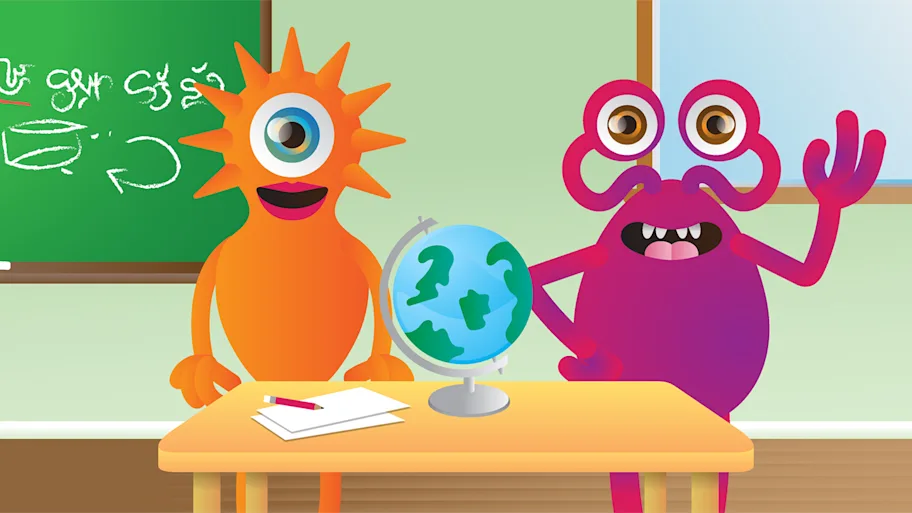- Science news
- Young Minds
- Communicating advanced mathematics to kids
Communicating advanced mathematics to kids
Note: This blog post was originally published on the American Mathematical Society Blog.
By Jeremy Martin, Professor, University of Kansas and Chief Editor for Understanding Mathematics.
I’ve often thought that we could do a lot better job of explaining “advanced” mathematics concepts in simple language for the benefit of a wider audience. As a student, I never liked being told, “We’ll explain that to you next year.” As a teacher, I’ve always wanted be able to give real answers to students’ exploratory questions: if a Calculus I student asks me a question whose precise answer requires knowledge of manifolds and de Rham cohomology, I want to be able to distill those ideas into an answer that this student can understand. Also, I’ve always enjoyed the challenge of telling non-mathematicians about Euler’s formula, or voting theory, the Four-Color Theorem, or the game of Nim. I have experimented with trying to explain my own research in algebraic combinatorics to an intelligent layperson.
For example, I recently coauthored a paper with the intimidating title “Oscillation estimates of eigenfunctions via the combinatorics of noncrossing partitions”, which is full of extensions of eigenfunctions, fractional Schrödinger operators, Kreweras complementation, and similar jargon. I summarized it like this: “My coauthors study partial differential equations, which model things like fluid flow and heat dispersion. They draw pictures that look like tangled-up spaghetti, then try to measure the complexity of the equations by counting the holes in the tangle. Well, counting is what I do for a living, and when I saw their pictures, I was able to use what I know about counting to help them solve their problem.” Sure, that’s sweeping a whole lot of things under the rug, but really, that’s what we were doing.
And that is how I ended up editing articles about mathematics for kids.
Frontiers for Young Minds is an online, open-access scientific journal. Authors write articles about topics they are experts on and submit them to the journal; the editor assigns a reviewer to read the article and submit comments, and works with the author to address them, and ultimately makes a decision about publication. Sounds familiar, right? There is one big difference. At this journal, the articles are not peer-reviewed. They are kid-reviewed. As you may have guessed from the title of the journal, the target audience consists of kids (ages 8-15), and who better than a prospective reader to tell the author what is working and what needs to be fixed?

I heard about Frontiers about a year ago from a biologist friend. The journal was founded in 2013 and has several established sections: Astronomy and Space Science, Biodiversity, Earth and its Resources, Health, and Neuroscience. Where was the Mathematics section? I wrote to the editor-in-chief (Robert Knight, a neuroscientist at UC Berkeley): “Why isn’t there a section on mathematics?” I got the response I expected: “Why don’t you start one?” Since then, we’ve put together a board of editors and Science Mentors (who assist the reviewers) from all area of mathematics for this newest section of the journal, which we’re calling Understanding Mathematics. We are about to publish our first article, on game theory, and we are encouraging submissions. I hope that you will consider contributing.
How can I get involved?
Write an article! Join the editorial board! Be a Science Mentor! Please! But especially, write an article — we need content!
What makes a Frontiers article?
They fall into two categories: “Core Concepts” (think Euler’s polyhedral formula, or the infinitude of the primes) and “New Discoveries” (your latest research breakthrough). Articles are short (2,000 words, approximately 4-5 pages) and should be fairly self-contained. It is okay (even encouraged) to suppress all the technical details; remember who the audience is.
Why should you write an article for Frontiers?
Because mathematics is fun and interesting and beautiful. If you’re reading this blog post, you know that. But you also know that non-mathematicians frequently perceive mathematics as tedious and boring and hard. And a lot of that attitude probably starts around ages 8-15 or so. So let’s try and change that. Why don’t we try explaining something wonderful like Euler’s polyhedral formula, or why there are exactly as many even numbers as counting numbers, or why there are infinitely many primes, or what the fourth dimension looks like? Why not communicate to kids that mathematics is a living subject, that we are constantly making new discoveries — think Fermat’s Last Theorem, the Poincaré Conjecture, the twin primes problem, or your own most recent paper?
How do I write for this audience?
Most of us mathematicians and scientists are used to an audience of fellow experts, even specialists. We write for readers who share our background knowledge and speak our lingo. We assume that they are comfortable with definitions, proof techniques, fancy notation, and all the other tricks of the trade. Writing an article that will be intelligible to 8- to 15-year-olds — especially the young end of this range — requires different strategies. The Frontiers editorial staff has a whole lot of suggestions about how to write for this audience. Here are some highlights:
“The goal is not to explain as much of your work as can possibly fit within ~2,000 words, but rather to craft a clear and self-contained explanation that covers all that a novice reader for your target age group might need to be able to understand your work.”
“If something is exciting, convey that excitement. If something is important, say exactly why it is important rather than burying that value within a paragraph of inferences and implications.”
“Unlike an academic abstract, which is meant to serve as a dispassionate summary of the academic content within an article, these abstracts are meant to draw readers in.”
Indeed, aren’t these principles just as valid in communicating to our colleagues and our students as they are in writing for young readers?
What’s a Science Mentor?
Science Mentors work directly with the young reviewers to explain what peer review is, guide the reviewers in reading and critiquing the submission, fill them in on any mathematics or science background they need, and act as the reviewers’ advocates in the next stages of the editorial process. If you’re a graduate student or a postdoc, this is a great way to get involved with Frontiers for Young Minds.
What’s the review process like?
Well, it’s similar to a “standard” journal: author submits article, reviewers give feedback, author revises article, and the process repeats until everyone is happy with the final version (as the shampoo bottle says, “lather, rinse, repeat.”). One difference is the interactive review forum, in which the author, the handling editor, and the Science Mentor (acting as the reviewers’ advocate) can communicate directly about revisions. Some articles are reviewed by one or two kids, some by an entire classroom. Sometimes the kids can be disarmingly frank (here’s one quote I like, from some years ago: “This seems important, but the way it is written is so boring I can’t even get to the end. Could the authors maybe sound excited about what they are doing?”)
David McAdams, the author of our first article, had this to say about the review process:
“The kids’ feedback is surprisingly helpful. Part of this is due to the Science Mentor, who elicits the most useful comments and then filters what the kids have to say, but I think it’s also due to the fact that the kids work as a team in reading and evaluating the paper. It’s as if an entire research group studied and debated your paper before preparing a jointly-authored referee report — much more useful and effective than the usual model of sole-authored reports.”
Even with authors and editors who are trying in good faith to write an article that is self-contained and readable by 8- to 15-year-olds (or a subrange of ages), it is easy to make incorrect assumptions about readers’ background knowledge. Sometimes these assumptions can be quite subtle. We need the reviewers to pinpoint these issues for us. It’s one thing to ask yourself how a 10-year-old reads; it’s another thing to be a 10-year-old. David McAdams reported that the kids, through the Science Mentor (graduate student Amanda Wilkens), had given him some crucial feedback: there wasn’t enough mathematics in the article. “I had gone a bit overboard in terms of being non-technical, to the point that mathematical arguments didn’t actually seem like math! I corrected this by adding a specific example with numbers, and the paper is much improved as a result.”
I not only hope that the journal will be a resource for kids who want to learn about mathematics, but also that writing a Frontiers for Young Minds article will be a rewarding experience for authors: here is an opportunity to communicate your work more broadly, not just for fellow specialists. Scientists who have submitted articles to the journal often tell the editors how anxious they were to receive the kids’ feedback: it can be a challenging task but a very satisfying one. (One author told us that he was pleased to have written an article that people might actually read!) I hope you’ll consider helping us grow by submitting an article on your favorite topic of mathematics.
Researchers interested in submitting versions of their work to Frontiers for Young Minds can find out more here.
Please contact kids@frontiersin.org for additional questions and to find out how to get started!






